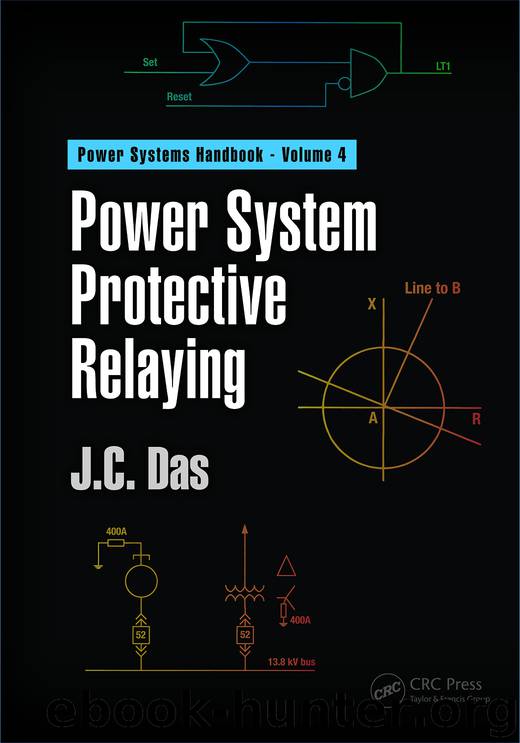Power System Protective Relaying by Das J. C.;

Author:Das, J. C.;
Language: eng
Format: epub
Publisher: CRC Press LLC
Published: 2018-04-15T00:00:00+00:00
By thermal magnetic circuit breakers (MCCBs) normally with fixed time delay characteristic and in large sizes with adjustable instantaneous magnetic characteristics, see Chapter 6
With MCPs which have only instantaneous magnetic characteristics adjustable over a certain range; the MCPs do not have a short-circuit rating of their own and are tested with motor contactor starters
FIGURE 10.13
Stabilization of a motor contactor for voltage dip.
10.7 Two-Wire and Three-Wire Controls
In a three-wire control, the contactor is maintained through an auxiliary contact in parallel with the start push button. This is the most common control used in the industry. If the contactor opens due to a low voltage, the coil circuit is broken by the auxiliary contact of the contactor; and the motor cannot restart unless the start push button is again operated. This control is referred to as three-wire control with loss of voltage protection, see Figure 10.14a.
A synchronous motor on loss of voltage acts as a generator for a short period of time and tends to maintain the AC terminal voltage for a longer period than an induction motor. See undervoltage protection for further explanation.
Figure 10.14b shows a as two-wire control. Here, the auxiliary contact of the contactor is omitted. The start–stop push button is replaced with a toggle or latched switch, pressure switch, or other types of maintained contact sensing device. The contactor will drop out at a certain low voltage and the motor will automatically restart when the voltage is restored. This is referred to as two-wire control and loss of voltage release. This has the disadvantage that many motors provided on the same bus will restart simultaneously, which will depress the voltage to an extent that the motors will never be able to restart. When two-wire controls are used, overload relays with automatic reset should not be applied. This will make the motors restart when the relays are self-reset.
Download
This site does not store any files on its server. We only index and link to content provided by other sites. Please contact the content providers to delete copyright contents if any and email us, we'll remove relevant links or contents immediately.
| Circuits | Digital Design |
| Electric Machinery & Motors | Electronics |
| Fiber Optics | Networks |
| Superconductivity |
Whiskies Galore by Ian Buxton(41570)
Introduction to Aircraft Design (Cambridge Aerospace Series) by John P. Fielding(32911)
Small Unmanned Fixed-wing Aircraft Design by Andrew J. Keane Andras Sobester James P. Scanlan & András Sóbester & James P. Scanlan(32590)
Craft Beer for the Homebrewer by Michael Agnew(17960)
Turbulence by E. J. Noyes(7744)
The Complete Stick Figure Physics Tutorials by Allen Sarah(7163)
Kaplan MCAT General Chemistry Review by Kaplan(6634)
The Thirst by Nesbo Jo(6487)
Bad Blood by John Carreyrou(6300)
Modelling of Convective Heat and Mass Transfer in Rotating Flows by Igor V. Shevchuk(6246)
Learning SQL by Alan Beaulieu(6058)
Weapons of Math Destruction by Cathy O'Neil(5881)
Man-made Catastrophes and Risk Information Concealment by Dmitry Chernov & Didier Sornette(5696)
Digital Minimalism by Cal Newport;(5423)
Life 3.0: Being Human in the Age of Artificial Intelligence by Tegmark Max(5216)
iGen by Jean M. Twenge(5194)
Secrets of Antigravity Propulsion: Tesla, UFOs, and Classified Aerospace Technology by Ph.D. Paul A. Laviolette(5086)
Design of Trajectory Optimization Approach for Space Maneuver Vehicle Skip Entry Problems by Runqi Chai & Al Savvaris & Antonios Tsourdos & Senchun Chai(4860)
Electronic Devices & Circuits by Jacob Millman & Christos C. Halkias(4770)
